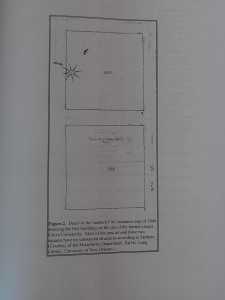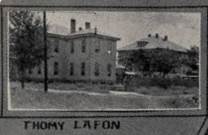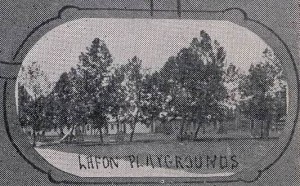PART TWO
This post is a continuation of our post of April 12, 2015 in which we introduced the beginning of the history of the very influential Thomy Lafon school.
This post was compiled from excerpts contributed by Mr. Keith Weldon Medley from research he has conducted on the Thomy Lafon school. He is a native of New Orleans and a two-time recipient of Louisiana Endowment for the Humanities’ Publication Initiative Grants. As a freelance writer, he has compiled over 100 writings on Louisiana’s history and culture.
“We rejoice at the opening of this beautiful school, named after one of our greatest philanthropists, Thomy Lafon…We strive each and every day to make Thomy Lafon school the model school of our city and state.” [Colonel James Lewis at a Patriotic Gathering at the Second Thomy Lafon School – 1906]
In 1906, six years after rioters destroyed the first school, the second public school named Thomy Lafon opened on South Robertson Street in the square bounded by Seventh, Eighth and Freret Streets.
Although the city council originally intended that the burned-out Lafon School be rebuilt on the same lot as the first school, the school board switched the site to place the new school on the remnants of the Locust Grove cemeteries that had been shut down in 1879 because of unsanitary conditions.

Placement of Thomy Lafon school. Locust Grove cemeteries No. 1 and No. 2 were in squares 360 and 363 on Freret Street between 6th and 7th streets.
[The Principal of the school, Mrs. [Sylvanie] Williams, [had a staff of 28] who held the title of Assistants instead of Teachers. Reaching out to her network of teachers, academicians, community and religious groups, Mrs. Williams and her associates combined education with the value of recreation, exercise, and community. In 1915 she and noted Black attorney James Madison Vance organized the Colored Playground Board with African American contributors raising $500 for equipment. With the city allocating $4,000 for sidewalks and curbing, the playground opened at the corner of Sixth and Magnolia Streets in 1916. The National Council of Social Work praised the playground as being one of the best playgrounds in the country.
Immediately before this transformation by Mrs. Williams and her associates, this “… plot of ground so highly commended was a sunken dumping place for refuse of all kinds, an offense to the neighborhood and to the negro public school which faced it. Its conversion to a spot of which the city can be proud was brought about by a group of public-spirited negroes working with the Playground Commission” praised the Times-Picayune newspaper.
However, prior to this activity, Thomy Lafon’s philanthropy and his bequests had long been ignored by the city of New Orleans. Again, according to the Times-Picayune, “After a long search through old records the negroes established the fact that the square at Magnolia and Sixth streets actually had been left by Thomy Lafon to the city to become a park, but had been utilized as a dumping ground.”
The year after Ms. Williams retired in 1921, 91 African American children graduated from the second public school named after Thomy Lafon.
The Colored Educational Alliance
In 1925, education activist Henderson H. Dunn and a prominent group of African Americans founded the Colored Educational Alliance of New Orleans with the purpose of lobbying the school board for funding and repair for African American schools. Overcrowding in schools had become a major problem and the night schools were overcrowded.
The Alliance consisted of prominent citizens such as W.G. Lucas of the NAACP, the New Orleans Comptroller of Customs Walter L. Cohen, ministers from varying denominations, doctors such as Joseph A. Hardin, and pharmacist E.J. LaBranche. The Alliance crafted a petition and met with school superintendent Nicholas Bauer to obtain equal funding and maintenance for schools such as Thomy Lafon that were ill-maintained.
In 1927, the efforts of the Colored Educational Alliance bore fruit when the school board erected a large annex building at Sixth and South Robertson Streets on the Thomy Lafon school campus. With the addition of the brand new annex, the Morning Tribune New Orleans newspaper called the school “one of the largest and finest public schools for negroes in the country” and the “largest educational building in N.O.” At the dedication, Principal S.J. Green received an American flag as civic organizers Eva Jones of the Parent-Teacher Club, representatives from Straight University and New Orleans University celebrated progress. Students from the Lafon School sang spirituals to commemorate the occasion.
The new wood-framed building housed 2700 students, 52 teachers, 18 classrooms, and a big assembly hall. It also provided classroom space for 110 girls who attended classes in domestic science and domestic art. In the 1927-28 school year, under the direction of principal S.J. Green, the Thomy Lafon School had the highest enrollment of students in New Orleans.
The Thomy Lafon School’s First Principal
The school’s first principal, Sylvanie Francoz Williams of Opelousas, played an exceptional role in the education of African American families. Extremely active in national and community affairs, the National Association of Colored Women selected Mrs. Williams as its fifth vice-president. She served as a member of the Federation of Afro-American Women and attended conferences sponsored by The National Association of Teachers. She also wrote for national publications on the social status of women. Mrs. Williams founded the Phyllis Wheatley Club to raise funds to build a sanitarium for African American women in New Orleans.
The Thomy Lafon School would go on to educate many more students in the upcoming decades but would end its days in controversy and ruin.
Lenora Gobert
For further information on Mr. Keith Medley and his writing please visit KeithWeldonMedly.com .
Sources: The Crescent City Pictorial, 1925, Amistad Research Center, Tulane University; “An Investigation Into the Ethnographic and Historical Significance of Holt Cemetery,” A Thesis by Christopher Morgan Branyon, University of New Orleans, 1998; “Said To Be America’s Best Playgrounds,” Times-Picayune, May 9, 1920.





CreoleGen and your fine New Orleans readers/supporters,
Might any of you have additional information about Sylvanie Fancaz (just today came across that odd maiden name) Williams and her Phillis Wheatley Club (affiliated with the National Association of Colored Women), especially the events surrounding the visit to the club by Susan B. Anthony during the National-American Woman Sufrage Association convention in January 1903? Might Mrs. Williams have been a friend of Louisa Bordenave Plessy? Or the A. P. Bedous? I know that she was a splendid teacher, suffragist, and a strong “race woman.”
Thanks, Adele Logan Alexander (alalex@gwu.edu)
Hello Adele,
At this time I do not have information about the events or if she was friends with the people you listed above, but she is an ancestor of mine. Her name was Sylvanie Francoz Williams. She was born in New Orleans and was the daughter of Fancois Francoz and Sarah Francoz. Sylvanie’s husband, Arthur P. Willaims was also a teacher and musician.
My late father, Dr. Otto W. Duncan, Sr., M. D., attended Thomy Lafon when Mrs. Sylvanie Williams was the principal. He recalled the sidewalks being laid. He stated that he sometimes helped to put coal or wood in the furnace during winter months. He was a native of Natchitoches, La. and began his education there at a private school in an A. M. E. Church, where he completed the third or fourth grade. He was sent to New Orleans to continue his education at Lafon, and lived with relatives who were in the city. He later graduated from Xavier Prep, Howard University and Meharry Medical College.
I began my public school education at Valena C. Jones. Miss Fannie Williams was the principal. I later graduated in the last eighth grade class at Lafon in 1952. Mr. Edgar P. Harney was the principal. My three younger siblings also attended Lafon.
Where was Thomy Lafon High School in 1933-5? I read the obit for David Bartholomew and it stated he was forced to drop out to help support his mother and sisters. I was trying to imagine where he would’ve been going to school.
First, we are not African Americans. We are indigenous Americans, and you foreigner, immigrants from Europe need to stop referring to us as foreigners. None of our people back then referred to themselves as African Americans. Perhaps we should call you pale folks from Europe, ALBINOS, as the Portuguese did, since you do not use the English word to describe us, which is BROWN or INDIAN RED.